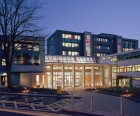Rejuvenating two 60-year-old buildings

Nik Chambers of Greenways studied at Royal Leamington Spa College when he was a young apprentice. Now he has helped transform those teaching buildings to achieve a ‘Very good’ BREEAM rating with the help of natural ventilation and LED lighting with controls.
Improving facilities while improving energy efficiency is a challenge that Warwickshire College Group has tackled successfully across several of its campuses. The showpiece £12 million redevelopment of the main teaching block at its Royal Leamington Spa College is an excellent example of how sustainable building-services engineering can play an important role in delivering asset improvements with long term environmental and financial benefits.
A pair of unremarkable buildings constructed in the 1950s, the main teaching block had changed little since I studied there as a young apprentice. The client wanted to do much more with the refurbishment than tick the boxes for sustainability, however, and the brief was to take the building beyond Part L requirements.
By combining efficient building services with a more thermally effective building envelope the scheme successfully slashed the electrical load by 30% and dramatically reduced the gas load to provide the college with a BREEAM ‘Very good’ sustainable building.
The programme had to be delivered by main contractor Speller Metcalf, as a heavily phased operational refurbishment, with an enabling project to renew the M&E supply and distribution infrastructure, followed by a floor-by-floor building services refurbishment scheme.
The college did not have sufficient teaching space to decant classes on campus, so the new mains distribution (omit the word ‘board’), LPHW heating systems and hot and cold water distribution network were installed first to allow a floor-by-floor strip out and enable the college to occupy most of the building throughout the refurbishment.
The biggest changes to the fabric of the building were the installation of new double glazing and a 10 cm insulated cladding system, which updated the teaching blocks’ appearance but also dramatically improved thermal performance. Speller Metcalfe also constructed a new atrium at the entrance to the building, providing a break-out area and space for meetings.
Greenways designed a natural-ventilation system for the new atrium, with automated window opening and louvered vents linked to temperature, CO2 and rain sensors. This system not only reduces the need for heating and cooling by providing a real-time, automated response to climactic conditions and CO2 levels, but will also be particularly useful for maintaining comfort in the summer by using it for night time cooling.
Other significant changes to the mechanical services included air-source heat pumps to provide the energy for the DHW supply throughout the two teaching blocks. While the air-source heat pumps were specified to provide all heat required, a gas-fired water heater was introduced to supplement this system as a back-up, significantly reducing the building’s gas consumption.

An energy-efficient DHW system was particularly important for these college buildings because of the nature of some of the vocational courses. One of the specialist teaching areas in the building is the health-and-beauty department, which includes a hair salon that needs a constant and reliable hot-water supply.
Including the specific requirements of the facilities into the specification was imperative in every detail of the building-services design. One example is ceiling-mounted radiant panels instead of wall-mounted radiators in the health-and-beauty suite to maximise available space and student safety.
The 30% reduction in the electrical load, despite the increase in area, has largely been achieved thanks to the use of LED lighting and lighting controls throughout. LEDs have been used for exterior feature lighting, classroom lighting and emergency lighting, with PIR sensors for automated switching.
The emergency lighting has been designed on a self-test self-reporting system, networked to a central building management system (BMS) to generate automated alerts of any faults to the maintenance team. The electrical installation also includes a fully addressable fire-alarm system that was designed to enable installation, programming and commissioning on a floor-by-floor basis before the old system was decommissioned.
In addition to the design challenges of specifying an operational refurbishment that would upgrade energy efficiency, the ‘industrial’ aesthetic concept developed for the interiors by architect Robothams meant that all the services needed to be designed neatly as a functional feature.
Existing concrete soffits were simply re-painted and services in classroom areas were exposed, making them accessible for maintenance as well as creating visual impact.
The aim of the project was to transform the existing property assets into an exemplar teaching space for a 21st century college environment, combining energy efficiency and low operational costs with modern aesthetics and inspirational learning spaces. The building-services specification helped it achieve those goals.







